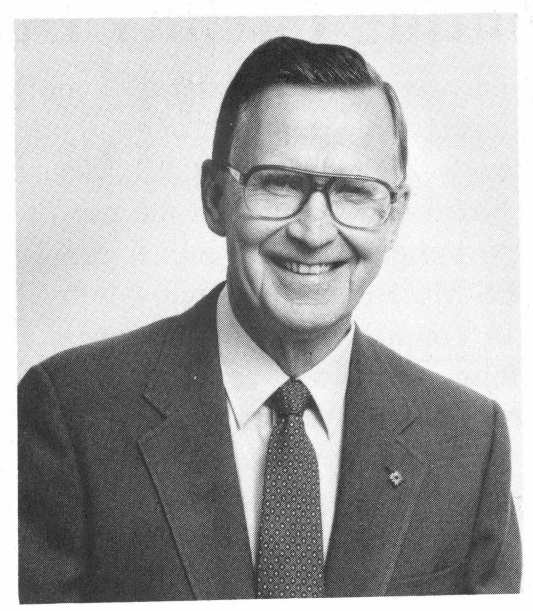Deputy Director Phil Livdahl "Retires" to Loma Linda Project

Phil Livdahl
"During these last nine years in the Directorate, I've had the tremendous experience of working with a group of very talented, very dedicated, and very willing people; I'm going to miss these them very much. And those sentiments extend to all the people I've worked with over my years here at Fermilab."
Those were the feelings expressed by Deputy Director Phil Livdahl on the eve of his retirement from Fermilab on September 17, 1987, after a career that found him deeply involved with every major advance the Laboratory has made.
Joining the fledgling National Accelerator Laboratory in late 1967, Phil set about the task of constructing and making operational the Linac. With a Linac ready to go, a Main Ring was the next logical step, and in 1971 Phil became one third of the three-manager system (along with Dick Lundy and Rich Orr) set up by then-Director Robert Wilson to finish construction of the Main Ring and make it operational. "We each had 150 or so people assigned to us," Phil recalled, "to do whatever had to be done on whatever day it needed to be done in order to get the machine up and running. We continued that way until that activity was finished and the machine was producing physics."
With the Main Ring complete, the Lab reorganized, setting up an Accelerator Division and a Research Division to facilitate completion of the experimental areas. Phil became Deputy Head of the Accelerator Division for the next few years, and he began working with Don Edwards, Bill Fowler, the late Will Hanson, Hank Hinterberger, Paul Reardon, Bruce Strauss, Lee Teng, and Wilson as the basic group laying plans for the fabrication of superconducting magnets, the foundation for the Energy Doubler/Saver project.
In 1978, with the departure of Bob Wilson, Phil became Acting Director. As Director Leon Lederman noted in his remarks on the occasion of Phil's retirement, "[When I became] Director Designate in the fall of 1978, I knew you were holding the Lab together, and that in itself was no small achievement."
"My years here have been fascinating," Phil said. "Looking back on it, one realizes that even the normal aggravations and frustrations were really very rewarding in the end. One gets to work with extremely bright people who are all very much of a single purpose: to do what you've set out to do. To have had an opportunity to be a part of the process of making things happen here has truly been wonderful.
"And, of course, working with Leon these past nine years has always been the most rewarding of experiences for me. He's an ingenious and unbelievable person. His imagination and his ability to carry things through is really quite remarkable."
All of which is mere prelude. "The reason I've made this change now," said Phil, "is so that I can spend all of my time on the Loma Linda proton therapy accelerator. When we designed Fermilab's agreement with the Loma Linda Medical Center in California, we excluded from Laboratory responsibility anything outside of the accelerator itself. In trying to put together an organization to take care of the equipment requirements for the rest of the facility, the administration of the Medical Center asked me if I would take on that responsibility. I couldn't do that and continue in the Directorate, so I decided that for once in my life I was going to get down to one job.
"The potential for the kind of treatment that will be done with this accelerator at Loma Linda has been understood for a very long time; Bob Wilson originally described the treatment of tumors with protons in a paper he wrote in 1946. Only recently has the diagnostic capability reached the point where we can realize that potential. Up to now, treatments have been done using physics machines, but they suffer from a serious limitation: they're not where the doctors are.
"The origin of the Loma Linda project goes back 20 years; they wanted a facility such as this at their medical center, but they didn't know how they could get it, and they began researching the problem in their spare time in 1970. Finally, almost two years ago, the Loma Linda people came to Fermilab and began the discussions which resulted in our agreement to carry the project forward."
Eventually, Phil's work on the medical accelerator will take him, and his wife Phyllis, to California, but at present he's sharing his time between Loma Linda and Fermilab while the proton accelerator undergoes prototyping at the Industrial Complex.
Again quoting from the Director's remarks at Phil's retirement: "How does one sum up your 20 years of service to Fermilab? You brought an unflappable steadiness to the team... Looking back, I really can't imagine what I, what the Laboratory, would have done without you.
"In your latest endeavor, too, the proton therapy accelerator, your efforts have brought together a large and diverse community in order to clarify the issues… Every retirement should have a bright prospect, and yours is as bright as they come. You stand a good chance to be the moving force behind a medical instrument that can have a profound effect on the treatment of dread diseases."


